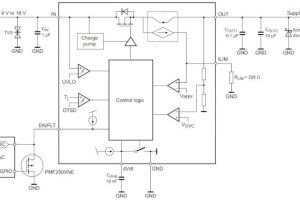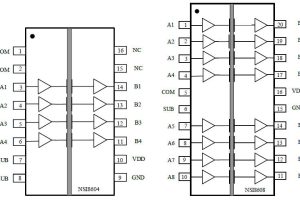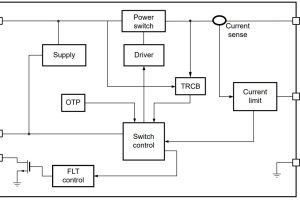Nexperia has created a pair of 17mΩ 13.5A resettable electronic fuses for 12V hot-swap applications in 3 x 3 x 0.75mm DFN3030-10 (SOT8037-1) packaging. NPS3102A and NPS3102B operate with 9 to 18V on the input (21V abs. max) and can limit output current to anywhere between 2 and 13.5A range, programmed using a resistor – the voltage across which can ...
Tag Archives: electronic
2MHz industrial isolated input ICs need only secondary-side power
Novosense Microelectronics has created a pair of isolated digital input chips suitable for 24V industrial control applications that only need power on the output side. 4-channel NSI8604 (SSOP16 package) and 8-channel NSI8608 (SSOP20) provide input/output isolation when converting voltages in the range of -60V to 60V to logic signals. (The third digit is a capital ‘i’, not a numerical ‘1’). ...
5V load switch includes reverse-blocking and current limiting
Nexperia has introduced its first 5V load switch IC, which operates across 2.5 – 5.5V with 110mA to 2.5A current limiting. The 2 x 2mm NPS4053, as it will be know, is optimised use in portable devices such as notebook computers, desktops and docking stations, and automotive infotainment systems – it is UL 62368 recognised and there is an AEC-Q100 ...
PCIM: SiC automotive e-fuse demo disconnects up to 30A 900V
Microchip has used silicon carbide power transistors in an electronic fuses demonstrator for electric vehicle batteries. “The demonstrator can detect and interrupt fault currents in microseconds, 100 – 500 times faster than traditional mechanical approaches,” according to the company. “The fast response substantially reduces peak short-circuit currents from tens of kilo-amps to hundreds of amps, which can prevent a fault ...
60A e-fuse occupies 5×4.5mm and works across 4.5-16V
Texas Instruments has created an 60A electronic fuse for system protection and power management (right), and a 50A version with added PMBus control. Called TPS25985x, the 60A device “provides multiple protection modes using very few external components and is a robust defence against overloads, short-circuits and excessive inrush current”, according to the company. Inside is a 0.59mΩ switch, and the ...
TI aims two all-electronic relays at 800V automotive batteries
TI has released a couple of isolated switch chips, one inductive and the other capacitive, to replace electromagnetic and opto-electronic relays in vehicles with 800V batteries. TPSI3050-Q1 is the inductively-isolated (5kVrms reinforced) IC, a switch driver that delivers a 10V gate drive on its secondary side as well as a continuous 50mW dc supply for auxiliary circuitry – so not separate secondary-side ...
Normally-closed e-relay is <2mm across
Panasonic is to squeezed a single-pole normally-closed mosfet relay into a 1.95 x 1.8 x 0.8mm TSON package. An extension of the company’s CC series, “we are pretty certain that our 1FormB TSON type is currently matchless throughout the industry as far as size and current consumption are concerned”, said Panasonic’s Michael Renner. “With just an eighth of a SOP4 package’s ...
Resettable e-fuse from Toshiba
Toshiba has expanded its range of eFuse circuit breaker ICs with a 53mΩ version that trips in 320ns, all in a 3 x 3mm package. Dubbed TCKE712BNL, it is aimed at consumer goods including cameras, cordless cleaners, cleaning robots, power tools, speakers, thermostats and wireless chargers. “Being automatically reset by an internal logic signal, unlike conventional glass fuses, they are ...
Tiny solar cells integrated into cloth at Nottingham Trent
Nottingham Trent University has developed a way to embed miniature solar cells into yarn that it said allows them to be knitted and woven into textiles: “The cells are encapsulated in a resin which allows the textile fabric to be washed and worn like any other form of clothing.” “Clothing would look and behave like any other textile, but within ...
Electronic fuse covers 8-48V and up to 4A
STEF01 is an 8-48V 4A programmable electronic fuse from STMicroelectronics. When connected in series to the main power rail, it protects the load against over-current and over-voltage. Voltage is clamped to a user-defined maximum, preset with external resistors. Excessive current is restricted to the programmed safe limit by controlling the internal power mosfet, and folds-back to a lower limit if ...
 Electronics Weekly Electronics Design & Components Tech News
Electronics Weekly Electronics Design & Components Tech News


